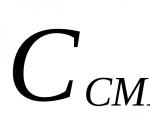Combinations of colors and color schemes in photography. Color wheel for the photographer. Let's start with the basics. Color wheel
Most of us use color thoughtlessly in photography. But once you take a selective approach to the tones in the frame and pay attention to the colors in the composition, you will see a qualitative change in your work.
We'll go back to basics color theory and tell you how to use color wheel to mix and match colors perfectly. Then we'll focus on the use of color and in various ways creating vibrant, captivating images.
If you decide to practice, then bright clothing items will come in handy. They can be inexpensive. First, we'll show you how to create a special look in a portrait by adding one bright color against a dominant neutral shade.
Then you can move on to experimenting with additional colors.
The third stage is to create striking effects by mixing shades of the same color. Finally, let's touch on the use of a great variety of different colors for fun rainbow photos.
And, importantly, you will learn how different lighting options can dramatically affect the perception of color in photography.
You probably know that color can have a huge impact on our mood. And its proper use is a great way to add vitality to your photos.
The simplest experiment with color is to add an accent of one bright shade to counterbalance the predominant neutral composition.
In this case, red color works flawlessly. Also, any warm shade, such as orange or light pink, will look good as a focal point.
The model in the photo above has red lips and a matching scarf, which clearly stands out against the background of the black coat and gray walls. The outline of the eyes brings life to the frame.

After mastering the simple use of one bright color, try contrasting two shades in a portrait.
The easiest way to choose two shades in a photograph is to use a color wheel. Colors that are directly opposite, such as orange and blue or red and green, tend to complement each other well.


The visual perception of different colors can cause very strong emotional reactions.
For example, red symbolizes passion and danger, while blue promotes relaxation and has an instantly calming effect.
You can deliberately evoke certain feelings in the viewer by using several shades of the same color in the photo. Our example combines shades of green. This creates a calming effect.

Choose the right white balance
For the two portraits above, different white balance settings were used, which dramatically affects the changes in the color palette of the image. In the first case, setting the BB “tungsten lamp” made it possible to soften the tone of the model’s purple dress and give the portrait a cool mood. In the second they saved natural light so as not to affect the different shades in the photo.
It happens that violating the rules and principles in photography gives an extremely pleasant effect. This also applies to color theory.
Try mixing and matching colors to see what happens. The more you experiment, the more you'll begin to understand what looks good and what just looks flashy.

In this portrait there were blue walls, a green dress, a purple scarf and yellow flowers, which, according to all the rules, should not happen in photography. But in combination with soft light, it was possible to create a quite attractive rainbow effect.
Designers usually use a blank with a palette of different colors and automatically get compatible shades.
For effective use Colors are crucial not only in choosing the right shades, but also in lighting.
Colors photographed in harsh sunlight will look very different compared to those photographed in dim indoor lighting. The key to how colors are perceived is the positioning of the light source. You can clearly see this in the three pictures below.
In each case, the scarf on the model looks completely different.
The use of backlighting gave new options for the perception of shades. You can mute colors to pastel shades and create different contrasts with side lighting. Moreover, the same principles apply to artificial lighting, and to the natural.
Front lighting

Placing the sun or other main light source directly behind the photographer will show colors as we perceive them in real life. That is, with all brightly and evenly lit tones. This is exactly what we see in the photo above with the model's rainbow scarf.
Backlighting

Color wheel
Most of us do not think about the color scheme of a photograph until a certain moment. Meanwhile, color has a strong impact on the viewer and greatly influences the perception of the photograph as a whole. Let's figure out what rules we need to know and apply so that our pictures are perceived harmoniously.
From school, we all know a saying that helps us remember 7 colors from the color spectrum: “Every Hunter Wants to Know Where the Pheasant Sits.” Those. We all remember that a light beam through a prism is refracted into 7 spectral colors: red, orange, yellow, green, blue, indigo and violet. In the artistic environment, these colors are represented in the form of a chromatic (that is, color) color wheel. So, let's look at this very color wheel and what it is eaten with.
All colors are formed on the basis of just 3 primary colors- red, blue and yellow.
If these colors are mixed equally, you get orange, green and purple. These colors are called composite. This is how we get a six-part color wheel.

And if the primary and secondary colors are mixed equally, then we get tertiary colors. 
When we put all these colors together we get the 12-part color wheel, which today is the basis of all color theory.

This color wheel can already be used to select harmonious color combinations. But still in this circle All colors are pure - bright and saturated. For photographs it is not advisable to use them in pure form, or better to dilute, i.e. add achromatic colors to them - black and white. This way you can get a huge variety of shades and tones within the same color. If we add white to the color, its saturation is reduced to pastel tones. Conversely, when adding black, the saturation of the base color will increase.

In other words, this dilution of chromatic colors with achromatic ones is called “color stretching,” which gives us such a color wheel based on the same 12 colors, but with many tones and shades.

Harmonious color combinations
What follows from all this and why should we know all this? But just in order to skillfully use harmonious combinations of colors in our photographs, making them interesting and more attractive to the viewer. So, the main ones harmonious color combination schemes the following.
Approximate examples are shown next to the diagrams (not necessarily in the same color, but in the same color scheme).
Monochrome (one-color) combination
A combination of tones and shades of the same color within one sector on the color wheel. That is, one color differs only in brightness and saturation. It is quite difficult to achieve such a combination in photographs (especially on the street), because... Rarely do we have a range within one color in nature. But if you wish, you can arrive at such a scheme through color correction; this is not difficult to do in studio photography.


Similar color combination- a combination of three adjacent colors in the color wheel (in the photo example - yellow, orange-yellow and orange).


Complementary (complementary) scheme- two colors that are opposite on the color wheel (red and green in the photo).


Broken Addition (or split complementary scheme)- a combination of colors, when in two opposite colors, instead of one color, two neighboring ones are taken (in the photo example, yellow, orange, blue).


Triad- a color combination of three colors equidistant on the color wheel (i.e. an equilateral triangle inscribed in a circle). The most interesting and beloved scheme by many. Ideally, one color acts as the main color in the composition, sets the mood, the second plays up and supports the first color, and the third sets accents.


There are other combinations that include four or more colors (rectangle, square - tetrad, pentagon). However, it is better not to use such a variety of colors for photography. This makes it very easy for very experienced artists (photographers, designers) and a person not very experienced in color to get confused and do nonsense.
Color theory and practical application by photographers
What follows from all this color theory and how can a photographer apply all this in practice?
To begin with, don’t be lazy to think through color scheme photos before filming begins. If this is a creative photograph, then at the stage of thinking through the image, immediately imagine the location and try to choose clothes that are in harmony with the color scheme. Commercial photography is no exception. Knowing the interiors of the studio or the location of the plein air shooting, discuss with the client the color scheme of the clothes so that in the end your photographs look beautiful and tasteful.
When processing, analyze the resulting colors in the photo. Which color is dominant, which colors set accents, which colors are superfluous and need to be completely removed from the frame (bleach, i.e. remove saturation, change the hue, or completely repaint them in a different color). Feel free to actively use tools for color correction and toning in Photoshop - color balance, selective color correction, curves, gradient map.
For analyzing colors and selecting harmonious combinations in Photoshop there is a very convenient tool - Cooler. It was available online on the Adobe website, and in the version of Photoshop CS6 it is built into the editor itself (Window-Extension-Cooler). The cooler is a color wheel that you can spin as you please, choosing color schemes and getting a palette of harmonious colors. It’s very convenient to analyze a photo and immediately turn the parameters of the color wheel side by side, changing the shades, brightness and saturation of colors. From the resulting palette, you can copy the color number directly into the Photoshop palette, using this for color correction, for example, the “Gradient Map” tools or “painting” with a brush in the “Soft Light” mode.

There is also another wonderful link - the same cooler online for everyone who works with color.
Who is interested in learning more about how to work with color correction and toning photographs in practice, welcome to our photo school for our course or.
The article uses photographs as examples from a photographer from our team.
The perception of a photograph depends on many components, including the colors and their harmony in the frame. Each color carries a psychological and emotional content, which the photographer uses to convey the meaning of the photograph.
Photography and primary colors
The primary colors are absolutely red, green and blue. If you mix these three colors, you get white, this indicates their harmony. In photography, all existing laws of color composition are oriented towards these three colors.
Color wheel. To comprehend what was written above, you need to see it all, because we are talking about visual art. The purpose of the circle is to show how colors can be combined and how to achieve their interaction.
The “color wheel” has primary and complementary colors. With this division it is much easier to consider the relationships between them. All primary colors are the brightest in the gamut. By adding white to them, we get lighter, pastel shades; adding black, we get colors in dark tones.
In this circle the primary colors are yellow, red and blue. That is, opinions on the “primacy” of colors also differ.

Photography and complementary colors
A complementary color is created by combining two primary colors. On the “color wheel,” secondary colors are located opposite the primary, which they do not contain.
- Red combined with yellow creates orange (the complementary color to orange is blue)
- Yellow when mixed with blue gives green (its complement is red)
- Blue and red create purple (the complement of purple is yellow)

By using colors located next to each other on the “color wheel,” you can create harmonious combinations. The color harmony in the photograph has a calming effect on the viewer. You can also create beautiful photos using “monochrome” color. This effect involves using the same color or shades of it, using soft light to flatten the color.

Important:
- A pure primary color is very strong and must be used in a photograph to ensure balance in the frame.
- in photographs, warm tones visually appear outward, making objects appear prominent, while cold tones, on the contrary, create depth without volume.
- Aesthetics in a combination of related colors is obtained by combining colors located between the primary and the secondary ones closest to them: yellow with green, yellow with orange, blue with green, blue with violet, red with orange, red with violet.

Hello, dear amateur photographers!
It's no secret that good photo depends much more on the skills of the photographer than on his equipment. A fancy camera does not guarantee beautiful pictures. The secret of successful shots lies in understanding technical features photographs, and how they interact with each other.
Today we will talk about an important component - color.
Color affects our perception. It can be a tool for composition, creating balance and contrast. Subconsciously, we react to color faster than to shape or volume. Colors can “deafen” and “hit” like sounds, or they can convey harmony in a laconic but meaningful range.
Colors also have the power to evoke different reactions in the viewer because we associate our moods and emotions with different colors.
Psychologically, colors can be divided into strong and weak, calming and stimulating, heavy and light, warm and cold.
Colors appear deeper on a white background, and brighter on a black background.

Each person has his own subjective attitude towards color. However, there are general, characteristic points in the perception of color by most people. For example, red is recognized as the most active and heaviest color, followed by orange, blue, green and, finally, white. If you take identical squares of different colors, red will seem the smallest, blue will appear larger, and white will appear to be the largest.

A curious fact about this psychological illusion of color. As you know, the Russian and French national flags have three color stripes of equal width: blue, white and red. So, on sea vessels the ratio of these bands changes in the ratio 33:30:37. This was done so that from a distance all three stripes would appear equal.
Color wheel
There is more than one model that describes the relationship of colors, but in photography the so-called color wheel is most often used. It consists of several sectors of different colors. There are three primary colors in a circle: red, yellow and blue. Orange, green and violet are called intermediate, they can be obtained by mixing the main ones.

The color wheel is the basis for understanding the interaction of colors. And here two simple principles apply:
- Neighboring colors in a circle form calm, harmonious combinations.
- Opposite colors form a contrasting combination.
At the same time, each of the contrasting colors seems brighter and more saturated.
There are several basic rules for working with color:
Selecting the direction of light
The shape and color of objects change depending on the nature of the lighting. By changing the direction and nature of the lighting, you can balance the colors.

Changing the shooting angle
By changing the position of the camera, you can greatly change the angle of illumination of an object and thereby significantly influence its color and shape.

The viewing angle, as opposed to the shooting angle, determines the position of the object that the camera lens can capture. It depends not only on the position of the camera, but also on the point from which the photographer looks at the subject. The concept of “lower” and “upper” angle is directly related to the lower or upper shooting points, i.e. unusual shooting angle.

The dominant color should be related to the main subject, and if the main color is not central to the composition, it is important that it supports and highlights the main subject. It is best when several colors are combined in an image into one whole.
Color accent
The strength of color depends to a large extent not only on quantity, but also on location. One yar Some color spots on a calm background can make a spectacular photo. A weak color accent can be strengthened if it borders on a contrasting color.

The contrast of color photography is expressed in the saturation and variety of tones (colors). Sharp, contrasting colors (when balanced) add effectiveness and strength to a photograph. Contrast is enhanced when red is combined with cyan, green with magenta, and blue with yellow.
The nature of this phenomenon lies in the physiology of our vision. The human eye cannot simultaneously bring into focus rays with different wavelengths ( focal length for red-yellow rays more than for blue-green). Therefore, when we see colors all together at once, the eye muscles begin to “twitch”, trying to adjust the waves. This psychological disharmony creates a feeling of contrast.

Basic combinations (colors located on opposite sides of the color wheel):
Blue - orange
Red - green
Purple - yellow
Complementary (colors, the combination of which gives the color located on the circle between them):
Red - yellow
Blue - red
Yellow - blue
Color harmony
Remember the photographs that, thanks to their color palette, really impressed you and caught your eye. Moreover, the presence of bright colors is not at all necessary; these photographs stand out among others thanks to the color relationship that the photographer himself builds.
To use and benefit from all the countless shades of color, we must have a good understanding of color theory. In this article, we briefly outlined for you the main postulates of color theory.
Let's start with the basics. Color wheel
Most likely, you have heard more than once about the existence of the color wheel, perhaps you studied its structure in childhood in drawing lessons. We invite you to refresh your knowledge.
We need the color wheel to understand how colors interact with each other, how they are combined. This is exactly what it was created for.
Within the color wheel, there are primary, secondary and tertiary colors, which together form the color spectrum. Thanks to this division, it is much easier to consider the relationship between colors. All initial colors are the brightest in the spectrum; adding white to them, we get lighter, pastel shades; adding black, we get colors in dark tones, respectively.
Now we will look at primary, secondary and tertiary colors.
Primary colors
The most basic, basic colors are red, yellow and blue. By mixing them in different proportions, we get all the other colors of the spectrum, and by adding black and white, we get their additional shades.
Complementary colors
Complementary colors (in other words, complementary) are secondary, i.e. are created by connecting two primary ones. On the color wheel they are located opposite the primary color, which they do not contain.
- Red + Yellow = Orange (complementary color Blue)
- Yellow + Blue = Green (complementary color is Red)
- Blue + Red = Purple (complementary color is Yellow)
We get aesthetic pleasure when we see colors in a painting or photograph that complement each other. A correctly selected color palette can significantly increase the visual effect. In photography, by combining complementary colors, we achieve contrast, which gives the image greater dynamism.
When photographing, try to look for these most complementary colors around you. Soon you will notice them everywhere.


Use the theory of the color wheel during staged filming and when composing a composition.

And when photographing portraits, this theory will be no less useful. In any photograph, the colors should be combined and look harmonious. When choosing an outfit for a model, think about what background you will be photographing her against, and, based on this, choose the color of the clothing. For example, a model in a yellow dress will look very impressive against a blue or purple background.
Similar colors
These are colors that are located next to each other on the color wheel.
For example, let's take green and blue-green, these colors are similar, just like yellow-green. Their combination gives a feeling of calm and harmony.
Warm and cool colors
The color wheel is usually divided into warm and cool colors. Warm colors are: red, yellow, orange. Cold, respectively: green, blue and purple. Interior designers very often use the properties of cold and warm colors. Cool colors can visually enlarge the space, while warm colors give a feeling of homeliness.
These facts can also apply to photography. When creating a composition, for an object whose color can be classified as warm, look for a background of the opposite, i.e. cold color. This will add drama to the photo. However, cold-colored objects do not always look harmonious against a warm background.
Knowing and understanding the physics of color, its psychology, and the ability to combine, you will be able to create expressive, spectacular photographs that attract the viewer’s eye. It is color that creates the entire mood of a photograph and makes one object stand out from the rest.




